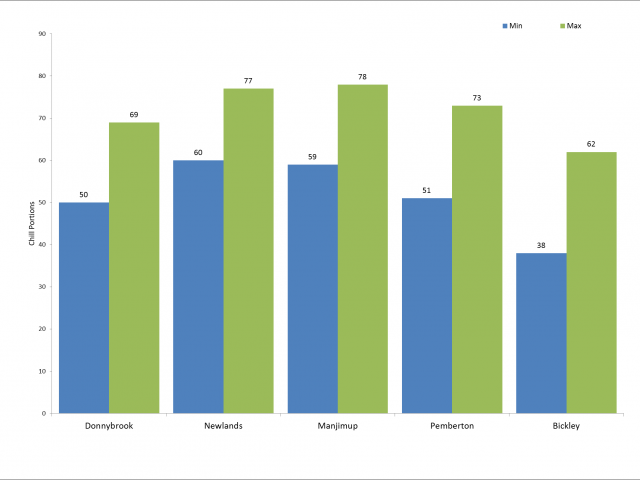Dynamic chill portions
The observed effects of temperature on dormancy breaking have been modelled over the autumn and winter period to give an estimate of total winter chill. The current model used to calculate winter chill is the Dynamic Chill Model (Fishman et al., 1987). It calculates chill as chill portions based on hourly temperatures. The optimum chilling temperature starts at 6 ºC and effectiveness tapers to zero at -2 ºC and 14 ºC. Temperatures above 14 ºC can negate previously accumulated chill. Adding all chill portions over autumn and winter provides an estimate of accumulated winter chill for the year.

Figure 1. The minimum and maximum limit of annually accumulated winter chill received for temperate fruit growing regions across WA from 1911-2012.
Safe winter chill
Safe winter chill is the term for the amount of chill portions required for a site to reliably produce fruit. This represents the minimum amount of winter chill a location is expected to reliably achieve 9 out of 10 years (figure 1).
Varieties requiring the safe winter chill or less should be able to meet their chilling requirements at least 90% of the time. For example, as shown in Table 1 producers farming in Donnybrook WA should aim to grow varieties that require a chill portion of 52 or less.
| Location | Safe Winter Chill Portions |
| Donnybrook WA | 52 |
| Manjimup WA | 64 |
| Applethorpe QLD | 69 |
| Tatura Vic | 81 |
| Huonville Tas | 105 |
There are only a few studies which have defined the varietal chill requirements using the Dynamic Chill Portion Model. The current projects are investigating the chill requirements of Lapins Cherry, Granny Smith apple and Cripps Pink apple using the Dynamic Chill Portion Model.
| Fruit | Variety | Chill Requirement |
| Apple | Golden Delicious | 50 |
| Apricot | Selene | 57.4 |
| Cherry | Lapins | 35 |
| Nectarine | Flavortop | 41.4 |
There are many unknowns about the dormancy processes and winter chill. A better understanding of winter chill and dormancy will enable improvements to be made with the Australian fruit industry.
